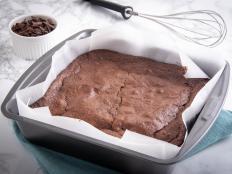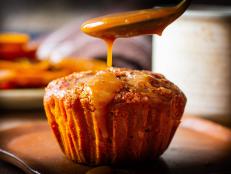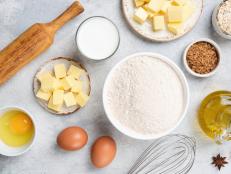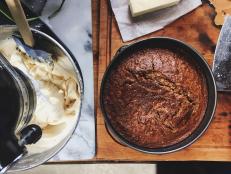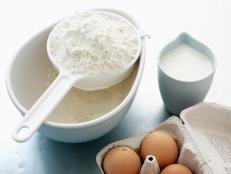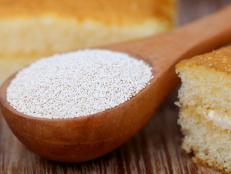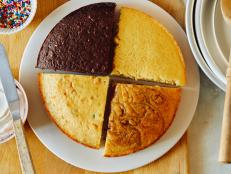This Baking Chart Helps You Convert Between Pan Sizes
Bookmark this for later.
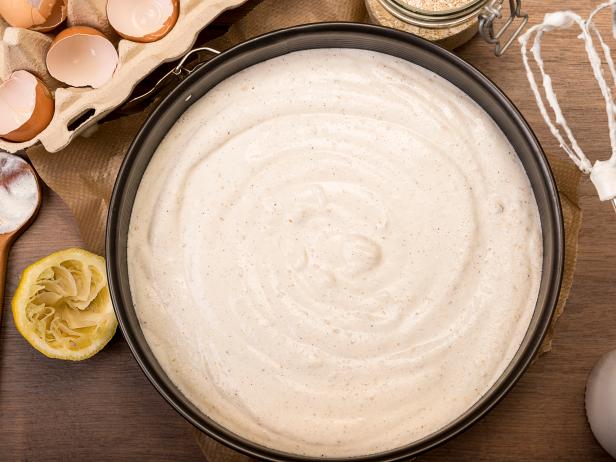
Westend61/Getty Images
By Miriam Garron and Melissa Gaman for Food Network Kitchen
Miriam is the Senior Director for Food Network Kitchen. Melissa is a recipe developer at Food Network.
If your recipe calls for a 9-inch cake pan but all you have is an 8-inch, we’re here to tell you how to convert between pan sizes. It might take a few calculations and some modifications, but if you follow our chart and tips, you can swap sizes and shapes with confidence.
How Do You Adjust Baking Cakes with Different Size Pans?
1. Keep the depth of the batter the same.
The amount of batter in a cake pan is an important part of the recipe. Too much batter, and the cake could sink in the middle or overflow. Too little batter, and you’ll end up with a thin, shallow and dry cake (the moisture will evaporate too quickly). Follow this rule when changing your pan size: fill the pan about halfway to two-thirds of the way full. If you have any batter leftover, bake it in muffin tins or a small dish.
2. Alternatively, tweak your baking time and temperature.
If you’re moving the recipe to a smaller pan and the batter seems too deep, bake low and slow: lower the oven temperature by 25 degrees F and increase the baking time. You may notice a slightly coarser texture in some cakes. If you’re moving the recipe to a larger pan, increase the oven temperature by 25 F degrees and decrease the baking time (you’ll still end up with a thinner cake, but the taste and texture should be fine). In both cases, use a cake tester to make sure the cake is cooked. Head over to pastry chef Hedy Goldsmith’s story How to Adjust Baking Time and Temperature for Different Pan Sizes for even more details.
Baking Pan Conversion Calculator
If you want to take the guesswork out of converting between pan sizes, check our chart which does math for you. It’s smart to be precise about pan sizes because, for example, a mere 1-inch difference in pan area between an 8-inch square pan and a 9-inch square pan ends up being big – a 14-square inch difference, making the 9-inch pan 25% larger. But: that 9-inch round is the same as an 8-inch square, so that’s a swap you can make without worry.
Here's how to follow our chart. Take a look at the pan called for in your recipe. If its area or volume matches that of another pan on the list (or comes very close), the other pan is a good swap. Keep in mind that pan volumes generally refer to the amount of filling it takes to reach the top of the pan. But remember the rule of thumb: you never fill a pan to the top. So when switching pans, you want the volume of the batter to be less than the specified volume of the pan.

Food Network Kitchen
How to Scale Recipes to Fit Different Sized Pans
If you can’t find a match on this chart, here’s how to scale a recipe so it fits in a different-size pan. Keep in mind that it’s easier to scale a recipe up or down if you weigh ingredients, especially using metric measurements. Measuring by volume is not hard, but it takes a little more work to halve a measurement like 1/3 cup (the easiest way would be to break it down into smaller units, like tablespoons, and then do your math).
To increase the volume of a recipe to fit a larger pan:
- Divide the area of the large pan by the area of the smaller pan the recipe calls for.
- Multiply the answer from step 1 (your conversion factor) with the amount of each ingredient in the recipe.
To decrease the volume of a recipe to fit a smaller pan:
- Divide the area of the small pan by the area of the larger pan the recipe calls for.
- Multiply the answer from step 1 (your conversion factor) with the amount of each ingredient in the recipe.
When You Should Not Convert Between Pan Sizes
It’s important to realize when swapping just isn’t the right move: batters that are developed for specialty pans are…developed for specialty pans and should probably stay in them.
- Bundt Cakes: Very sweet, wet batters generally do better in Bundt or tube pans, with center tunnels that support the batter and transmit heat to the center.
- Angel Food Cakes: This batter can sometimes be swapped out of tube pans with removable bottoms to springform pans, but not into nonstick pans – the batter needs to adhere to the pan as it rises.
- Cheesecakes: They generally need the support of the 3-inch-high, removable sides of springform pans.
Related Links:
























